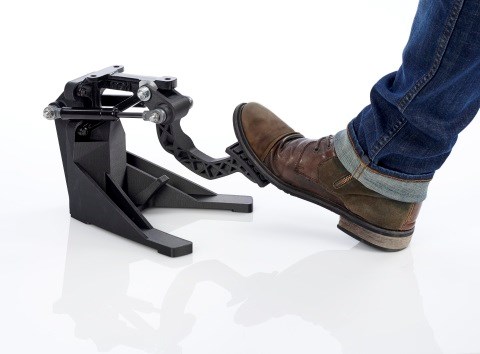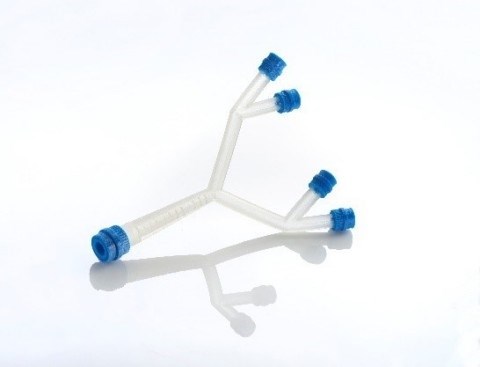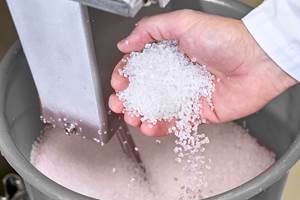Additive Mfg. Materials Evolve as Market Moves from Prototyping to Production
Both Stratasys and Arkema have recently launched new materials with improved aesthetics and performance.

Within the last few years, as additive manufacturing has burgeoned with new and optimized 3D printing equipment, materials development has been surging along as well.
In fact, experts in the technology have long professed that in many respects materials hold the key to the advancement of additive manufacturing—particularly as the trend toward short-run manufacturing grows. Two companies have recently introduced new materials.
Stratasys has added to two new materials to its 3D printing materials portfolio—one designed for the FDM process, and one for the PolyJet process.
β FDM Nylon 12CF, is a carbon fiber-filled thermoplastic strong enough to replace metal components in a range of applications. It is said to be ideally suited for a wide range of final part and tooling applications where the combination of stiffness, strength and low weight is critical to the performance. Examples include drill guides, end-of-arm tooling, brackets, jigs, fixtures, and even metal-forming tools.
“We believe that the impressive strength-to-weight ratio of the FDM Nylon 12CF is transforming for many industries from consumer goods and recreational goods to automotive and aerospace… it enables designers to develop more practical and functional designs and gets them to market faster, without worrying about how to prototype those parts using metal or molding,” said v.p. Zehavit Reisin, head of Rapid Prototyping for Stratasys.
The FDM Nylon 12CF is designed for the Fortus 450mc Production 3D Printer and is compatible with soluble support SR-11-. It requires and updated version of Insight software and a hardware upgrade. The material can produce parts in a layer thickness of 0.010 in. (0.254 mm). It is expected to start shipping in Q2 2017.
See video:
β The Agilus30 family—Agilus30 and Agilus30 Black—is designed for designers and engineers that need to simulate flexible materials. It is said to allow for greater freedom to handle and test flexible parts and prototypes while delivering excellent accuracy, fine details and enhanced product realism.
The Agilus30 family’s all-around rubber-like performance and compatibility with soluble support (SUP706) reportedly makes these materials an excellent choice for modeling delicate parts that undergo flexing and bending. It is expected to generate interest for mechanical engineers, RP managers and industrial designers. Examples of applications include overmolding, soft-touch, and living hinges, hoses, seals and gaskets, as well as knobs, grips, pulls, and handles. Agilus30 is compatible with Objet260/350/500 Connex1/2/3 Printing platforms and is available for shipping now.
See video:
Meanwhile, at next week’s (March 19-23) 2017 Additive Manufacturers User Group (AMUG) conference and expo in Chicago, Arkema will highlight recent advances in high performance nylons, PVDF, PEKK, and photocure resins. The company notes that as the industry turns from prototyping to short-run manufacturing, exciting polymer advances have resulted in improvements in both aesthetics and mechanical performance for the life of manufactured parts. The company will also present two technical papers:
“The First Polyamide 11: The High Performance Material of Choice,” by technical polymers development manager Arnard Lemaitre, entails Arkema’s Invent nylons for powder bed fusion and specifically address the mechanical properties required for manufacturing end-use parts.
“Block Copolymer Assembly for 3D Printing,” by William Wolf, technical service engineer for Sartomer, an Arkema subsidiary and leading global supplier of specialty acrylates and methacrylates, will address new developments in the N3xtDimension product line for photo-curable 3D printing materials. The company commercially launched this family of UV-curable materials last November. Said to represent the best in class performance for acrylate-based systems, this family of resin now spans a large range of viscosities offering broad tailorability—from formulation flexibility to drop-in systems to meet individual user requirements.

Related Content
The Fantasy and Reality of Raw Material Shelf Life: Part 1
Is a two-year-old hygroscopic resin kept in its original packaging still useful? Let’s try to answer that question and clear up some misconceptions.
Read MorePrices Bottom Out for Volume Resins?
Flat-to-down trajectory underway for fourth quarter for commodity resins.
Read MorePolymer Showdown — PC/ABS vs. PC/PBT — May the Best Material Win
First in a series, experts from plastics engineering consultancy The Madison Group will pit leading thermoplastics against each other to see how they differ in processing characteristics, chemical resistance, thermal and mechanical performance, and more.
Read MoreGeneral Polymers Thermoplastics to Further Expand Distribution Business
NPE2024: Following the company’s recent partnership buyout, new North American geographic territories are in its sight.
Read MoreRead Next
People 4.0 – How to Get Buy-In from Your Staff for Industry 4.0 Systems
Implementing a production monitoring system as the foundation of a ‘smart factory’ is about integrating people with new technology as much as it is about integrating machines and computers. Here are tips from a company that has gone through the process.
Read MoreLead the Conversation, Change the Conversation
Coverage of single-use plastics can be both misleading and demoralizing. Here are 10 tips for changing the perception of the plastics industry at your company and in your community.
Read More












